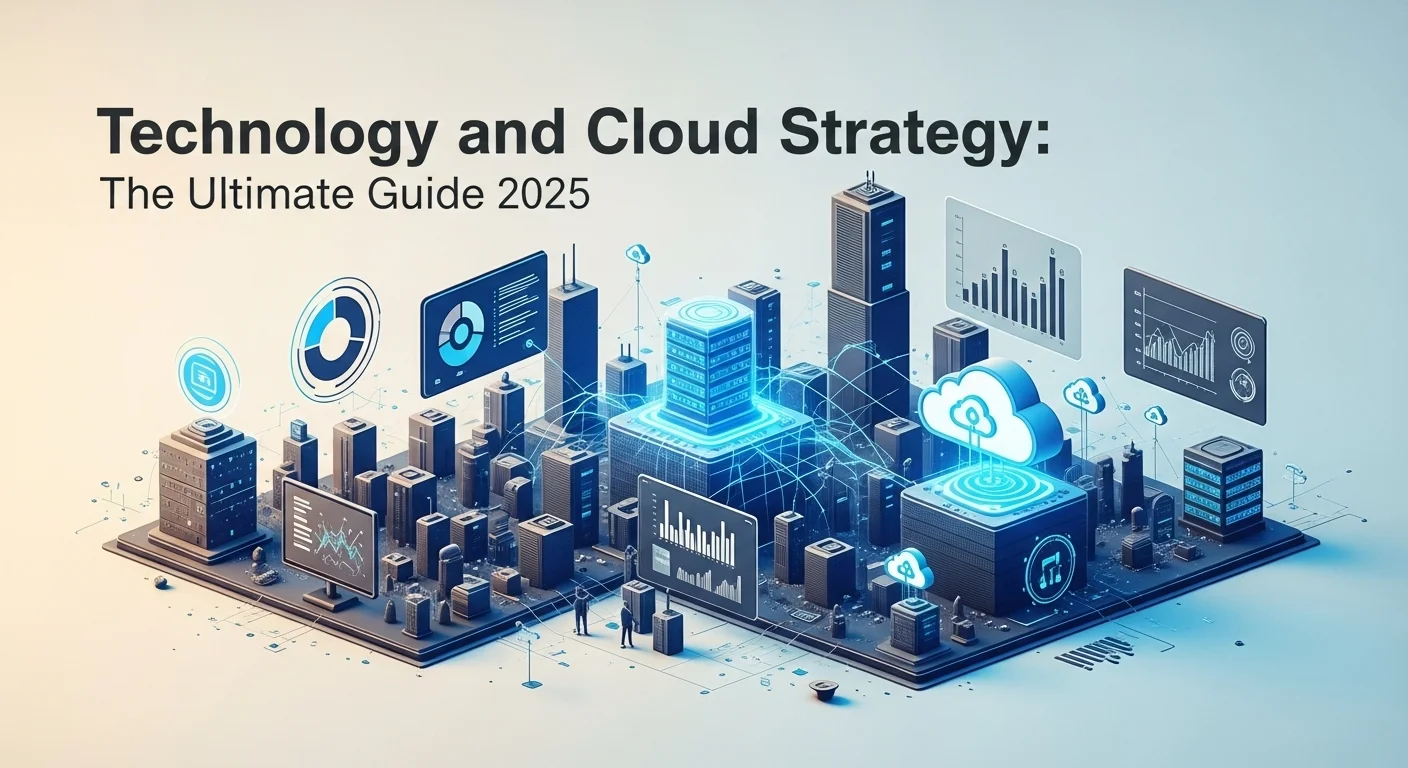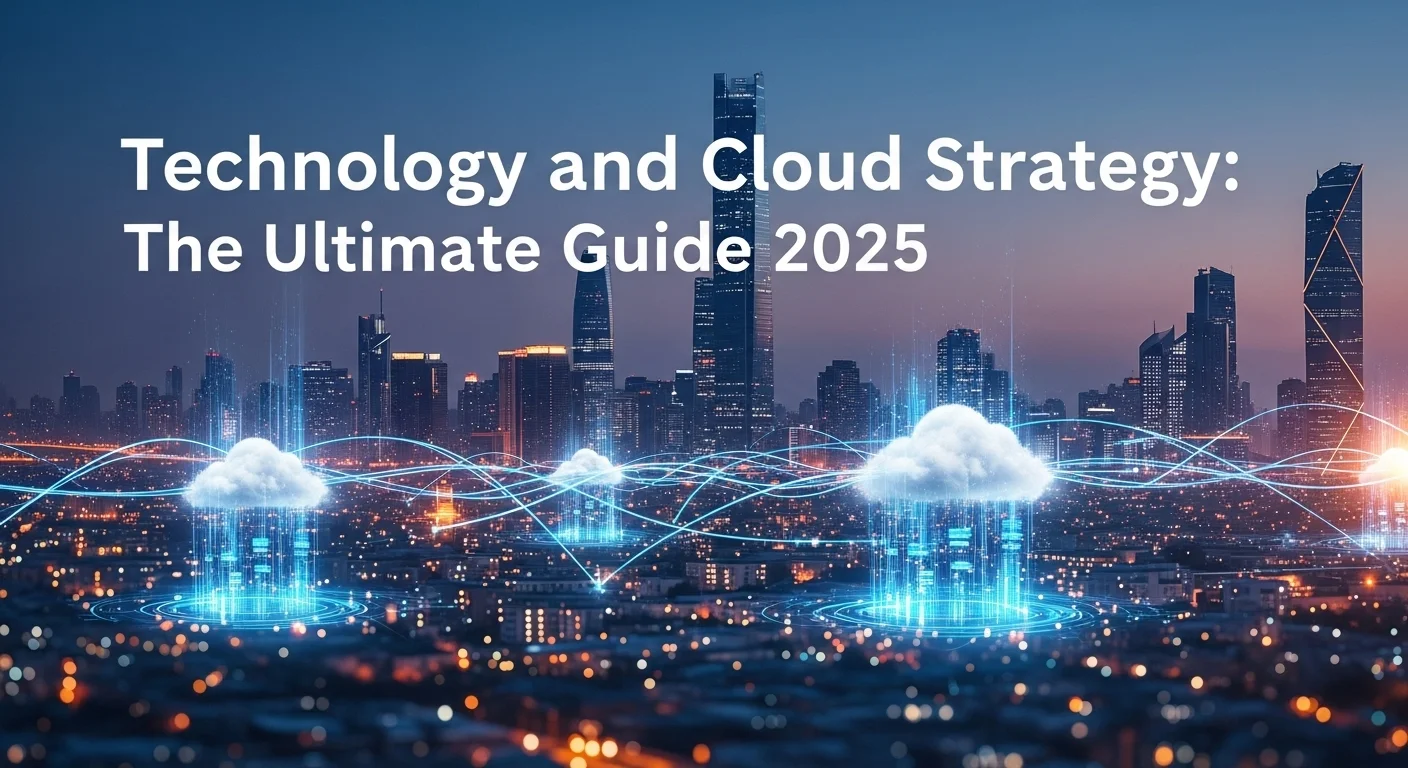Your Practical Guide to Cloud Strategy: Turning Plans into Business Success

Executive Summary
I've seen it countless times in my career: companies rush to the cloud expecting magic, only to end up with chaos and soaring bills. Why? They're setting sail without a map. A solid cloud strategy isn't just IT jargon; it's your business's roadmap to using technology effectively. It’s about making deliberate choices that boost your agility and align with your core goals. In this guide, I'm going to cut through the noise and share my hands-on experience. We’ll cover everything from building a plan from scratch to understanding the real differences between private and hybrid clouds—in simple terms. We'll also dive into creating a security framework you can trust and look at how giants like Oracle fit into the picture. My goal is to give you the confidence to harness the true power of the cloud, whether you're a CEO, an IT pro, or just starting to get curious.
Table of Contents
Table of Contents
What is a Cloud Strategy, Really?
In my line of work, I hear 'the cloud' thrown around constantly. But just using cloud services isn't a strategy. It's like buying a bunch of powerful tools without knowing what you're building. A real cloud strategy is your blueprint. It's a clear, documented plan that explains exactly how you'll use cloud technology to hit your business targets. Think of it as the essential link between your tech decisions and your business results. It ensures every move you make is smart, cost-effective, and pushes you towards goals like being more nimble, saving money, or innovating faster. I've seen firsthand that without a clear strategy, companies face messy IT, security risks, and unpredictable costs that actually slow them down. A well-thought-out plan turns cloud adoption from a tech project into a powerful business advantage.
The Pillars of a Strong Strategy
From my experience, every great cloud strategy rests on a few key pillars. They're the foundation that makes your plan practical and business-focused, not just a technical document. The first is Business Alignment. Every single thing you do with the cloud must support a specific business goal. Want to enter a new market or make customers happier? Your cloud plan needs to show exactly how it helps achieve that. The second pillar is Governance and Control. This is about setting the rules of the road for security, costs, and operations. A solid governance plan prevents uncontrolled spending and ensures you're meeting legal and regulatory requirements. Next is the Technological Framework. This is where you pick your tools—the right service models (IaaS, PaaS, SaaS) and deployment models (public, private, hybrid). This is the part where understanding the pros and cons of a private or hybrid cloud becomes so important. The final pillar is your Operating Model. This defines who runs the show long-term—the teams, the skills, and the processes you'll need to manage and optimize your cloud environment for years to come. Together, these pillars give you a solid structure for success.
Choosing Your Cloud: Public, Private, or Hybrid?
One of the biggest decisions you'll make is picking the right deployment model. There's no single 'best' answer; it all depends on your needs for security, control, and cost. Here's how I break it down for my clients:
- Public Cloud: Think of providers like Amazon Web Services (AWS), Microsoft Azure, and Google Cloud. You're using their massive infrastructure over the internet. The big win here is incredible scale and a pay-for-what-you-use model. It's perfect for websites, development, and applications with spiky traffic.
- Private Cloud: This is a cloud environment built just for you. It can live in your own data center or be hosted by a third party. The main benefits are maximum control and security. I often recommend a private cloud strategy for companies in finance or healthcare that have strict compliance rules or highly sensitive data. It can be a bigger upfront investment, but the peace of mind and customization are priceless.
- Hybrid Cloud: This is the 'best of both worlds' approach, mixing public and private clouds. You can keep your most critical data safe in your private cloud while using the public cloud's power for less sensitive tasks. It’s a popular starting point because it offers flexibility without forcing you to go all-in on one model. It’s the pragmatic choice for many businesses.
- Multi-Cloud: This just means using more than one public cloud provider. You might use AWS for one thing and Google Cloud for another to get the best features from each or avoid being locked into one vendor. It adds a layer of complexity but also a lot of power.
Why a Secure Strategy is Non-Negotiable
Let me be clear: security cannot be an afterthought. A secure cloud strategy must be baked in from day one. I've seen the fallout when it's not, and it's never pretty. A secure plan is about protecting your data, applications, and infrastructure from all angles. This means having strong Identity and Access Management (IAM) to control who sees what, encrypting your data whether it's sitting still or moving across the network, and setting up digital fences like firewalls. It also means proving you're compliant with rules like GDPR or HIPAA, which is a big reason many opt for a private cloud strategy. And you need a plan for what to do when something goes wrong—because it's not a matter of 'if', but 'when'. Without a proactive, layered security plan, all the benefits of the cloud can disappear in an instant.
Understanding the Major Players and Enterprise Needs
The cloud world has its giants like AWS, Azure, and Google, but a smart enterprise cloud strategy often looks beyond them. For large companies, it’s about creating a seamless ecosystem. Take the Oracle cloud strategy, for instance. If your business runs on Oracle databases and applications, their cloud is built to make those workloads sing. It offers a clear, high-performance path for their existing customers. A successful enterprise plan is often a mix—a hybrid and multi-cloud approach that uses the strengths of different providers. The goal is to build an efficient, secure IT environment that supports everything from old-school legacy systems to brand-new applications. It's a complex puzzle, but with the right strategy, you can create a real competitive edge.

Building Your Cloud Strategy Step-by-Step
Alright, let's get practical. Moving from theory to action requires a clear, methodical process. Building a great cloud strategy isn't something the IT department does in a locked room; it's a team sport involving people from across the business. I'm going to walk you through the essential steps I've used with clients to build an enterprise cloud strategy that actually works and lays the groundwork for real transformation.
Step 1: Know Where You Stand (Assessment and Discovery)
You can't plan a journey without knowing your starting point. The first step is to get a crystal-clear picture of your current IT landscape. This means making a list of every application, server, and piece of data you have. You need to understand how they all connect, what they need to perform well, and how critical they are to the business. In my experience, this discovery phase is where you find the 'low-hanging fruit'—apps that are easy to move—and the 'monsters' that will need more work. Using automated tools to map everything out can save you a world of headaches here.
Step 2: Define Your 'Why' (Business Objectives and KPIs)
With a clear view of your 'as-is' state, it's time to define your 'to-be'. What does success look like? This is where you turn broad business goals into concrete targets. Don't just say 'we want to save money.' Say 'we want to reduce IT operational costs by 20% in 18 months.' Are you trying to launch products faster? Aim to 'cut application deployment time by 50%.' These specific Key Performance Indicators (KPIs) give you a clear destination and a way to measure if your cloud investment is paying off.
Step 3: Choose the Right Cloud Model and Architecture
Now for the fun part. Based on your assessment and goals, you can make smart decisions about your cloud model. Will you go all-in on public, or does a hybrid approach make more sense? For many, the simple hybrid cloud strategy framework is a great start: keep sensitive data on-premise in a private cloud and use the public cloud for everything else. If you need a detailed private cloud strategy, this is where you'd pinpoint which systems need that extra layer of control for security or compliance. You'll also start designing your future cloud setup, including how your network will look and how your data will be managed.
Step 4: Pick Your Partners (Vendor Selection)
Not all clouds are the same. Choosing a provider should be a careful process based on your specific needs. Look at their services, performance, security certifications, pricing, and support. While the big three get all the attention, don't overlook others. For example, if you're an Oracle shop, the Oracle cloud strategy and its infrastructure are designed specifically for your needs and should be a top contender. I always recommend running a few small 'proof-of-concept' projects to test drive a provider with your actual workloads before you commit.
Step 5: Create Your Migration Roadmap
Moving to the cloud isn't like flipping a switch; it’s a carefully planned journey. I like using the '6 R's' framework to decide what to do with each application: Rehost (a simple 'lift-and-shift'), Replatform (a few tweaks), Repurchase (switch to a SaaS version), Refactor (rebuild it for the cloud), Retire (get rid of it), and Retain (leave it where it is). Your roadmap should organize these moves into logical waves, starting with the ones that offer the biggest impact with the least effort.
Architecting a Secure Cloud from the Ground Up
Security must be woven into every step of your plan. Building a secure cloud strategy means creating multiple layers of defense.
- Identity and Access Management (IAM): This is your digital bouncer. It ensures only the right people can access the right things. Always use multi-factor authentication (MFA)—it's one of the simplest and most effective security boosts.
- Data Protection: Your data needs protection everywhere. That means encrypting it when it's stored and when it's moving across the internet. Classifying your data to know what's most sensitive helps you apply the right level of security.
- Network Security: In the cloud, you build your own fortress walls. Use tools like virtual private clouds (VPCs), firewalls, and subnets to control who and what can get in and out.
- Compliance and Governance: Your security plan must meet the standards for your industry. This requires constant monitoring and logging to prove your controls are working. This is a huge driver for a private cloud strategy where you have maximum control.
Keeping Costs Under Control (Financial Management)
One of the biggest cloud myths is that it's automatically cheaper. The pay-as-you-go model is flexible, but it can get out of control fast without good governance. This is where FinOps—financial operations for the cloud—comes in. A key part of your enterprise cloud strategy must be a plan for managing costs. This means setting budgets, tagging resources to track spending, and setting up alerts. Regularly review your usage to shut down waste. Using the right tools to optimize costs is essential to getting the financial benefits you were promised.

Taking Your Cloud Strategy to the Next Level
Getting your strategy implemented is a huge win, but the work doesn't stop there. The cloud is always changing, so your strategy should be a living, breathing thing that you continuously refine. In this last section, I want to share some advanced tips and look at what's on the horizon. This is about moving from simply *using* the cloud to truly *mastering* it for your business.
From Using the Cloud to Mastering It: Advanced Optimization
Once you're up and running, the game shifts to optimization—getting better performance, lower costs, and smoother operations.
- Deep Cost Optimization: Go beyond basic budgeting. Use cloud tools to hunt down and eliminate waste, like idle servers or unattached storage. Set up automated policies to 'right-size' your instances so you're not paying for power you don't need. For non-critical tasks, using 'spot instances' can save you up to 90%—a trick the pros use all the time.
- Performance Tuning: A great cloud experience is a fast and reliable one. Use monitoring tools to get a deep look at your application's health. This allows you to spot bottlenecks before they become problems, tune your databases, and use things like Content Delivery Networks (CDNs) to make your service snappy for users anywhere in the world.
- Automation with Infrastructure as Code (IaC): This is a complete game-changer. Using tools like Terraform, you can define your entire IT setup in code. This means you can build, tear down, and rebuild perfect environments in minutes, not days. It dramatically reduces human error and is a core part of how fast-moving tech companies operate today.
What's Next? Trends Shaping the Future of Cloud
The tech world never sits still, and your enterprise cloud strategy needs to keep an eye on the future to stay competitive. Here’s what I’m excited about:
- AI and Machine Learning: AI is becoming the new engine of the cloud. Providers are rolling out incredible AI/ML services that can do everything from power intelligent chatbots to find hidden patterns in your business data. A smart strategy looks for ways to weave these AI tools into your business to boost efficiency and create new opportunities.
- Serverless and FinOps: Serverless computing lets you run code without thinking about servers at all. You only pay for the exact moment your code is running. It’s incredibly efficient and forces you to be smart about financial management (FinOps) to track and optimize those tiny costs.
- Edge Computing: With billions of IoT devices coming online, it doesn’t always make sense to send all that data to a central cloud. Edge computing brings the processing power closer to the source—think smart factories or autonomous cars. A forward-looking strategy will plan how to blend edge and central cloud for powerful, real-time applications.
A Deeper Look at Vendor and Multi-Cloud Strategies
While your overall strategy is key, execution often means getting deep into specific platforms. For instance, if you're an Oracle customer, mastering the Oracle cloud strategy is vital. You need to understand how their infrastructure is uniquely built for high-performance databases and ERP systems. At the same time, nobody wants to be locked into a single vendor. This is why a multi-cloud approach is so popular. It lets you pick the best tool for the job from different providers—maybe using Google for data analytics and Azure for your applications. Managing this requires great governance and tools that give you a single pane of glass to see everything.
The Most Important Factor: Your People
I'll end with the most critical point: technology is only half the battle. Your cloud strategy will only succeed if you have the right culture and people to back it up. I've seen more initiatives fail due to people problems than tech problems. A successful move to the cloud means shifting your culture to be more agile and collaborative. Invest in training your teams. Your system admins will become cloud engineers; your developers will learn new ways to build. Fostering a DevOps culture, where development and operations work hand-in-hand, is the secret sauce to unlocking the cloud's speed. At the end of the day, a great cloud strategy is one that empowers your people to do their best work and drive the business forward.
Expert Reviews & Testimonials
Sarah Johnson, Business Owner ⭐⭐⭐⭐
As a small business owner, I was intimidated by the cloud. This guide broke it down clearly. I would have loved a section with a simple cost-comparison template, but it's a great starting point.
Mike Chen, IT Consultant ⭐⭐⭐⭐
Solid overview. As an IT consultant, I appreciated the clear breakdown of the different models (hybrid, private, etc.). It reinforced a lot of what I advise my clients on. Good read.
Emma Davis, Tech Expert ⭐⭐⭐⭐⭐
Fantastic article! It connected the dots between the tech and the business goals, which is often missing. The section on building a cloud-ready culture really hit home. Sharing this with my team.



